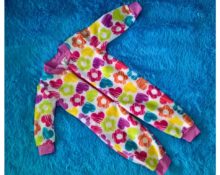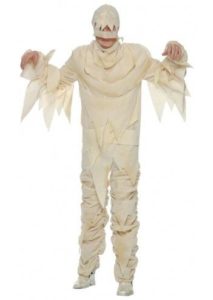 Halloween celebrations usually take place in the warm and friendly company of a variety of monster masks. At such parties, the Egyptian mummy costume is always popular. It is produced quickly, does not require special skills and large financial costs.
Halloween celebrations usually take place in the warm and friendly company of a variety of monster masks. At such parties, the Egyptian mummy costume is always popular. It is produced quickly, does not require special skills and large financial costs.
We'll tell you how to make such an outfit with your own hands.
How to make your own mummy costume
The material for dressing up a mummy for Halloween can be old fabric and bandages, or regular toilet paper. True, in the latter version you won’t have to show off your carnival new clothes for long.
From toilet paper
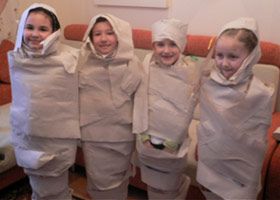
This is the most budget option for a suit. Unless, of course, you use pipifax from the Japanese company Hanebisho as the material, costing up to $17 per roll. The suit is made in a matter of minutes, and, having played its role, also quickly becomes unusable. Another disadvantage of the fairy-tale outfit is that you should avoid getting water on it, otherwise, instead of the original outfit, you may end up with a pile of wet paper.
- As a base, we take 2-3 rolls of dull gray toilet paper. To prevent the material from unwinding and last at least a few minutes, you can prepare several paper clips.
- Making a mummy starts with the feet. We wrap the paper around the ankle several times and secure it at the bottom with a paper clip, which will prevent the paper from unwinding immediately. But you can do without improvised means.
- We shape both legs in turn, and then smoothly move to the torso.
- The arms are wrapped from the hands.
- Lastly, create a paper hat on your head.
Now you can show yourself to the guests. But you should walk slowly, trying to carefully bend your legs and arms. Squats are also excluded. Another disadvantage of such a quick suit is that after removing it, there are a lot of scraps of paper left behind. Therefore, you will have to arm yourself with a broom and dustpan to clean everything up.
From bandages
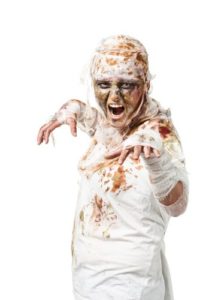
Regular medical gauze bandages are suitable for the suit. But first they should be given a dirty brown color, otherwise the mummy will more closely resemble a patient in the traumatology department.
Reference. To dye, it will be enough to pour hot water into a basin and put a few tea bags or add thick tea leaves.
You can also use paints by dissolving them in water to obtain a gray liquid.
Rolls of bandages are placed in water, kept for several minutes and wrung out. The workpieces are dried on batteries.
The costume will require approximately 60 packs of bandages. Therefore, you can paint a ready-made suit. To do this, take a wide brush, dip it in the prepared gray or brown solution and apply it over the entire surface of the outfit.
The bandages are wrapped around the body in the same order as toilet paper, but more carefully and in several layers, leaving no gaps.Gauze rolls can simply be tied together, hiding the knots between the layers. In the classic version, the head is also bandaged, leaving a narrow gap for the eyes.
From fabric
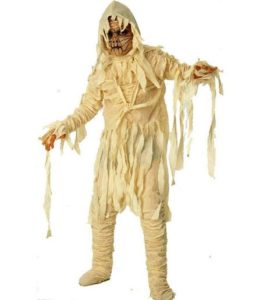
The most labor-intensive process is creating a mummy costume from fabric and attaching it to a base. This outfit can be used more than once, striking others with its lifeless appearance.
Instead of bandages, use old sheets or duvet covers. In the absence of such, you will have to buy several meters of natural material.
These types of fabrics are suitable for work.
- Linen. Due to its weaving, the fabric looks like ancient bandages. It is better to buy undyed linen; it comes in gray or beige.
- Cotton. Basically, it is a denser and less expensive fabric. Can be painted well.
- Calico. Another type of dense natural fabric. Raw calico of a milky beige color works well as stripes for a suit.
The fabric is cut into strips 5–7 cm wide. It can also be torn by hand, then the edges will look more natural. If the selected material is white, it is worth getting it a little dirty. To do this, the prepared strips are placed in boiling water with a dye, which can be strong solutions of tea, coffee or onion peels.
A turtleneck, sweatpants, and thermal underwear are suitable as the basis for a suit.
Strips of fabric are sewn onto the base, starting from the bottom. Each subsequent layer is attached in such a way as to hide stitch marks with its bottom edge. The sleeves and trouser legs are trimmed in the same way.
The fabric can also be sewn on by hand.
Important! It is not advisable to use safety pins to secure the strips.
They may open up. In this case, the suit will be ruined, but you can still get hurt.
Makeup and attributes

To prevent the mummy from looking too unrealistic, makeup can be applied to all exposed areas of the body. Foundation will also work.
Particular attention to the face. It should look pale gray and bloodless. To do this, the face is covered with white makeup.
It is advisable to highlight the cheekbones in a dark tone, which will create a thin and haggard look. The eyes are outlined with a black pencil, and dark or yellow-green shadows are applied around them, including the eyebrow area.
If the face remains open, then you can draw a small spider web on the cheek or forehead using a black or silver pencil.
Tips for making a costume
Even a new mummy costume, which is called “brand new”, should look as if it was sewn more than a century ago. Therefore, a few good tips will help bring your chosen image to perfection.
- When sewing strips of fabric, leave the long ends free. This will create the appearance of shabby and dilapidated.
- Apply a few strokes of red paint to the suit. Our mummy is not only scary, but also bloodthirsty.
- For the female version of the mummy, you can only design a short tunic. White stained stockings will complement the suit.


 0
0
